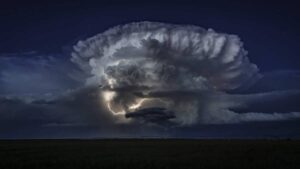American West continues to knock out high grade copper hits at Storm

American West keeps hitting thick, high grade copper intervals at its Storm project in Canada. Pic via Getty Images.
American West continues to intersect thick and high-grade copper intervals that demonstrate the consistency and scale of near-surface mineralisation at its Storm project in Canada’s Somerset Island.
The latest assays from drilling at the 4100N Zone returned a top interval of 1.5m grading 8.2% copper from a down-hole depth of 86.9m within a 3m zone at 5% copper from 86.9m that is itself located in a broad 29m interval at 1.2% copper from just 62.5m (SR23-13).
American West Metals (ASX:AW1) says the results continue to expand the volume of near-surface mineralisation and provide further support for the potential of the large gravity anomaly located below the 4100N Zone.
Copper mineralisation at this zone also remains open in all directions, which is never a bad thing.
“Further outstanding results have been received for the current drilling program at the 4100N Zone, with assays continuing to show the consistency and scale of the high-grade near-surface copper mineralisation,” Managing Director Dave O’Neill said.
“We continue to see thick intervals of copper mineralisation hosted within predictable stratigraphic horizons. Copper grades of 8% Cu highlight the quality of the mineralisation, and there is opportunity to expand the higher-grade zones with the mineralisation open in all directions.
“Our drilling this year has significantly increased the volume of the near surface mineralisation at Storm, and the scale of this alone is quickly shaping up to be what we believe will be a globally significant, low-cost copper project.”
He added that the results provided further encouragement for the potential of the recently defined and exceptional exploration targets at depth, particularly the largest target that is located below the 4100N Zone and immediately adjacent to the large fault that is interpreted as the main conduit for the copper mineralisation coming to surface.
Drill results are in
The latest assays stem from holes SR23-07, SR23- 08, SR23-09, SR23-13, SR23-14, and SR23-15 that were drilled within the central part of the 4100N Zone and were prioritised to allow for resource modelling to continue on drill sections with complete data sets.
Notably for American West, the results continue to demonstrate consistent copper grades and the excellent lateral continuity of the known copper mineralisation, which is open along most sections and is defined by broad intervals of vein and fracture style chalcocite, bornite and lesser chalcopyrite hosted within a distinct, horizontally extensive dolomite.
Particularly, hole SR23-13 that was drilled north of SR23-03 which intersected 67m at 1.1% copper confirmed the extension of the thick mineralisation to the north and intersected a broad interval of strong copper sulphide mineralisation with three higher grade bands, the lowest of which returned the top grade of 8.2% copper.
It also remains open to the north in an area with significant electromagnetic anomalism.
The company said the new data from the 4100N Zone has helped to further improve its understanding of the geological setting and mineralisation processes of the Storm copper system.
This has revealed a laterally extensive zone of mineralisation that displays many of the features of a typical sediment hosted copper deposit, including multiple stacked copper horizon.
Importantly, the geology of the 4100N displays marked similarities to that observed in hole ST22-10 to the west that has tested deeper parts of the system.
This hole targeted a large EM anomaly and intersected typical sediment hosted mineralogy including chalcopyrite, pyrite, sphalerite, and galena.
American West noted that the geological similarities and spatial association between the 4100N Zone and ST22-10 suggests that the two types of mineralisation may be related and form part of a large, stacked copper system which hosts several prospective stratigraphic horizons.
Results to date also suggest that a large-scale copper system is present within Storm with the geology of the area displaying all the elements required in the sediment-hosted ore forming process.
A distinct zonation of metal and mineralogy is also observed at Storm, which appears as a large copper-rich core that gives way laterally and vertically to thinner peripheral zones of copper-iron, iron, zinc, and minor lead – a powerful vector for exploration.
These key features are like many of the world’s major sediment-hosted copper systems, including the deposits of the Kalahari Copper Belt and Central African Copper Belt.
Looking ahead
Drilling at 4100N will be followed by resource definition drilling at the 2200N and 2750N zones where previous drilling by the company during 2022 intersected high-grade copper sulphides close to surface including 41m at 4.18% copper from 38m.
Processing and interpretation of the MLEM data is almost complete and drilling is being planned to follow-up any new MLEM anomalies.
The company has also scheduled diamond drilling to test the large geophysical copper targets below the near-surface mineralisation defined in recent EM and gravity surveys while ore sorting, beneficiation and process optimisation is continuing on a range of ore types.
Additionally, an environmental baseline survey will begin in the Storm area during the third quarter of this year.
This article was developed in collaboration with American West Metals, a Stockhead advertiser at the time of publishing.
This article does not constitute financial product advice. You should consider obtaining independent advice before making any financial decisions.
Related Topics

UNLOCK INSIGHTS
Discover the untold stories of emerging ASX stocks.
Daily news and expert analysis, it's free to subscribe.
By proceeding, you confirm you understand that we handle personal information in accordance with our Privacy Policy.








